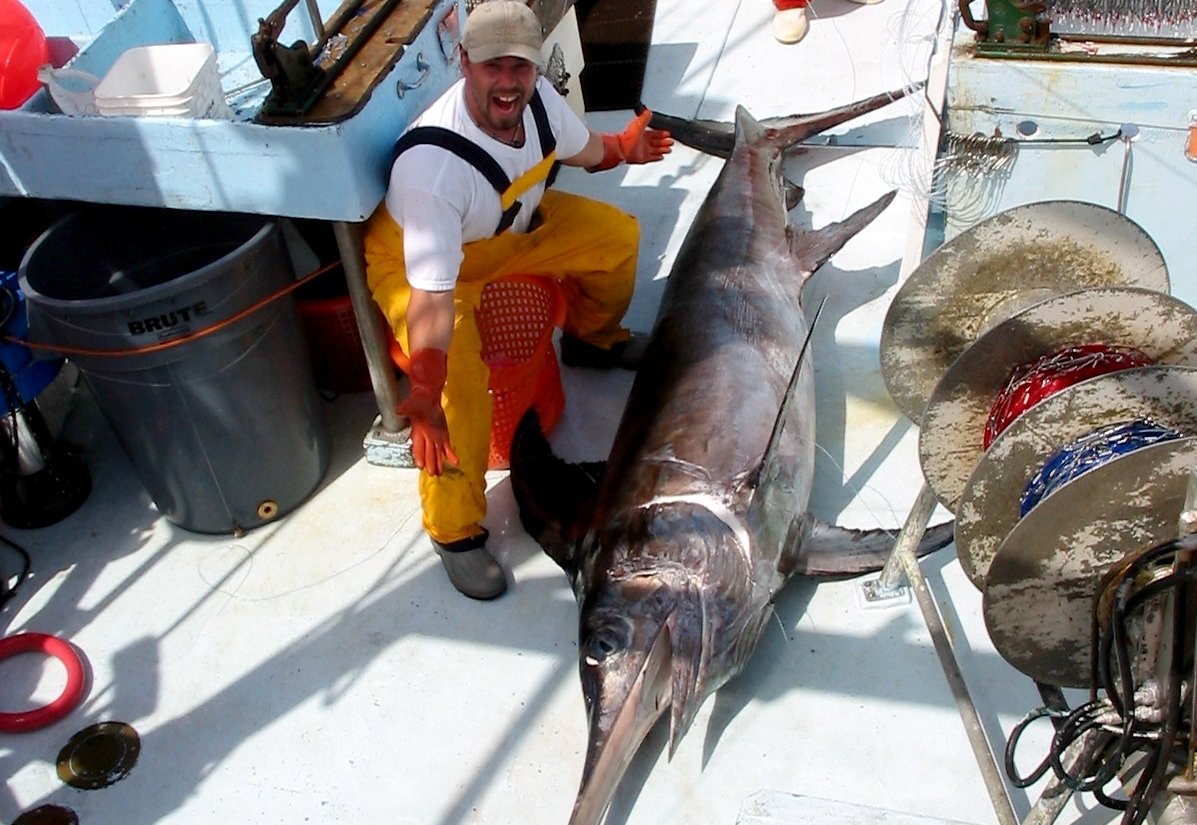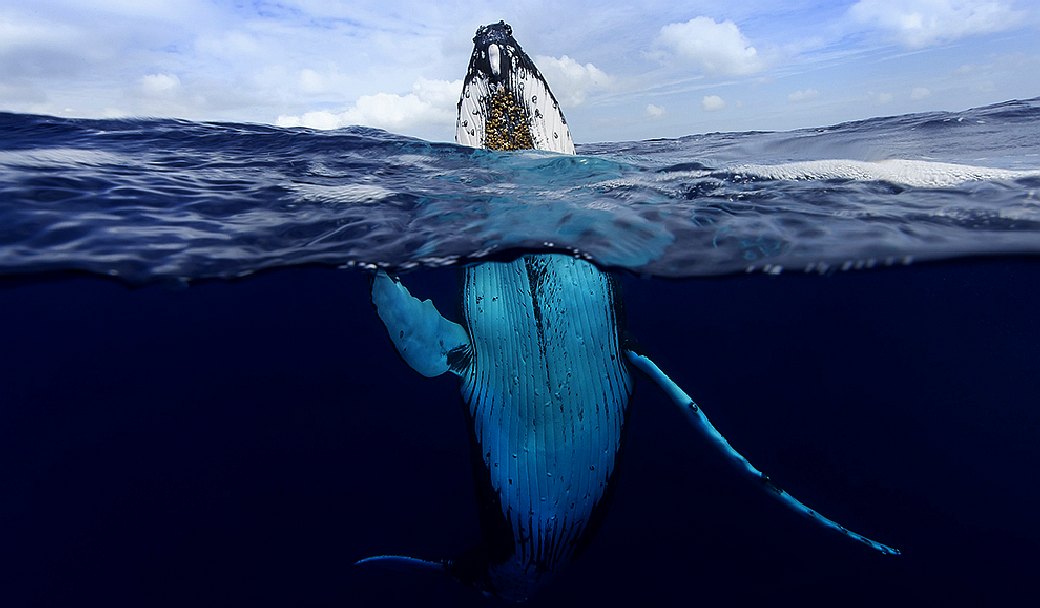|
SWORDFISH
ABOUT
-
HOME - WHALING
- A-Z INDEX
Anchovies
| Bass
| Bream
| Catfish
| Clams
| Cod
Coley
| Crabs
| Crayfish
| Eels
| Grouper
| Haddock
| Hake
| Halibut
| Herring
| Jellyfish
Krill
| Lobster
| Mackerel
| Marlin
| Monkfish
| Mullet
| Mussels
| Oysters
| Perch
| Piranha |
Plaice
| Pollock
| Prawns
| Rays
| Sablefish
| Salmon
Sardines
| Scallops
| Sharks
| Shrimp
| Skate
| Sole
| Sprat
| Squid
| Sturgeon
| Swordfish
| Trout
| Tuna
| Turbot
| Whiting

CATCH
- Classed as a game fish, this large swordfish was caught
commercially.
In
an effort to feed a
growing population we should look at
alternatives lower down the food chain to increase the ratio
at which protein is harvested from the ocean, so bypassing the
conventional food chain where at each stage of consumption
there are significant losses in the conversion process. Jellyfish,
squid, krill
and filter feeders such a mussels could play a part in filling the widening gap between falling
fish stocks and higher demand to feed
humans - so
relieving the pressure on tuna, salmon and other popular white
fish.
The problem being that plastic
in the ocean is poisoning all marine life, making seafood
potentially toxic and a health
risk in years to come.
ABOUT
SWORDFISH
The swordfish is named after its pointed, flat bill, which resembles a sword. The species name, Xiphias gladius, derives from Greek ξιφίας (xiphias, "swordfish"), itself from ξίφος (xiphos, "sword") and from Latin gladius ("sword"). This makes it superficially similar to other billfish such as marlin, but upon examination, their physiology is quite different and they are members of different families.
They commonly reach 3 m (9.8 ft) in length, and the maximum reported is 4.55 m (14.9 ft) in length and 650 kg (1,430 lb) in weight. The International Game Fish Association's all-tackle angling record for a swordfish was a 536 kg (1,182 lb) specimen taken off Chile in 1953. Females are larger than males, and Pacific swordfish reach a greater size than northwest Atlantic and Mediterranean swordfish. They reach maturity at 4–5 years of age and the maximum age is believed to be at least 9 years.[4] The oldest swordfish found in a recent study were a 16-year-old female and 12-year-old male. Swordfish ages are derived, with difficulty, from annual rings on fin rays rather than otoliths, since their otoliths are small in size.
Swordfish are ectothermic animals; however, along with some species of sharks, they have special organs next to their eyes to heat their eyes and brains. Temperatures of 10 to 15 °C (18 to 27 °F) above the surrounding water temperature have been measured. The heating of the eyes greatly improves their vision, and consequently improves their ability to catch prey. Of the 25,000+ fish species, only 22 are known to have a mechanism to conserve heat. These include the swordfish, marlin, tuna, and some sharks.
FISHING
Swordfish were harvested by a variety of methods at small scale (notably harpoon fishing) until the global expansion of long-line fishing. They have been fished widely since ancient times in places such as the Strait of Messina, where they are still fished with traditional wooden boats called feluccas and are part of the cuisine in that area.
Swordfish are vigorous, powerful fighters. When hooked or harpooned, they have been known to dive so quickly, they have impaled their swords into the ocean bottom up to their eyes. Although no unprovoked attacks on humans have been reported, swordfish can be very dangerous when harpooned. They have run their swords through the planking of small boats when hurt. In 2015, a Hawaiian fisherman was killed by a swordfish after attempting to spear the animal.
FOOD
Swordfish are classified as oily fish. Many sources, including the United States Food and Drug Administration, warn about potential toxicity from high levels of methylmercury in swordfish. The FDA recommends that young children, pregnant women, and women of child-bearing age not eat swordfish. (See mercury in fish for more details.)
The flesh of some swordfish can acquire an orange tint, reportedly from their diet of shrimp or other prey. Such fish are sold as "pumpkin swordfish", and command a premium over their whitish counterparts.
Swordfish is a particularly popular fish for cooking. Since swordfish are large animals, meat is usually sold as steaks, which are often grilled. Swordfish meat is relatively firm, and can be cooked in ways more fragile types of fish cannot (such as over a grill on skewers). The color of the flesh varies by diet, with fish caught on the East Coast of North America often being rosier.
CONSERVATION ISSUES
In 1998, the US Natural Resources Defense Council and SeaWeb hired Fenton Communications to conduct an advertising campaign to promote their assertion that the swordfish population was in danger due to its popularity as a restaurant entree.
The resulting "Give Swordfish a Break" promotion was wildly successful, with 750 prominent US chefs agreeing to remove North Atlantic swordfish from their menus, and also persuaded many supermarkets and consumers across the country.
The advertising campaign was repeated by the national media in hundreds of print and broadcast stories, as well as extensive regional coverage. It earned the Silver Anvil award from the Public Relations Society of America, as well as Time magazine's award for the top five environmental stories of 1998.
Subsequently, the US National Marine Fisheries Service proposed a swordfish protection plan that incorporated the campaign's policy suggestions. Then-US President Bill Clinton called for a ban on the sale and import of swordfish and in a landmark decision by the federal government, 132,670 sq mi (343,600 km2) of the Atlantic Ocean were placed off-limits to fishing as recommended by the sponsors.
In the North Atlantic, the swordfish stock is fully rebuilt, with biomass estimates currently 5% above the target level. No robust stock assessments for swordfish in the northwestern Pacific or South Atlantic have been made, and data concerning stock status in these regions are lacking. These stocks are considered unknown and a moderate conservation concern. The southwestern Pacific stock is a moderate concern due to model uncertainty, increasing catches, and declining catch per unit effort. Overfishing is likely occurring in the Indian Ocean, and fishing mortality exceeds the maximum recommended level in the Mediterranean, thus these stocks are considered of high conservation concern.
In 2010, Greenpeace International added the swordfish to its seafood red list.
LINKS
& REFERENCE
https://

MARINE
LIFE - This humpback whale is one example of a magnificent
animal that is at the mercy of human
activity. Humans are for the most part unaware of the harm their fast-lane
lifestyles are causing. We aim to change that by doing all we
can to promote ocean
literacy.
Anchovies
| Bass
| Bream
| Catfish
| Clams
| Cod
Coley
| Crabs
| Crayfish
| Eels
| Grouper
| Haddock
| Hake
| Halibut
| Herring
| Jellyfish
Krill
| Lobster
| Mackerel
| Marlin
| Monkfish
| Mullet
| Mussels
| Oysters
| Perch
| Piranha |
Plaice
| Pollock
| Prawns
| Rays
| Sablefish
| Salmon
Sardines
| Scallops
| Sharks
| Shrimp
| Skate
| Sole
| Sprat
| Squid
| Sturgeon
| Swordfish
| Trout
| Tuna
| Turbot
| Whiting
This
website is provided on a free basis as a public information
service. Copyright © Cleaner
Oceans Foundation Ltd (COFL) (Company No: 4674774)
2022. Solar
Studios, BN271RF, United Kingdom.
COFL
is a charity without share capital.
|

